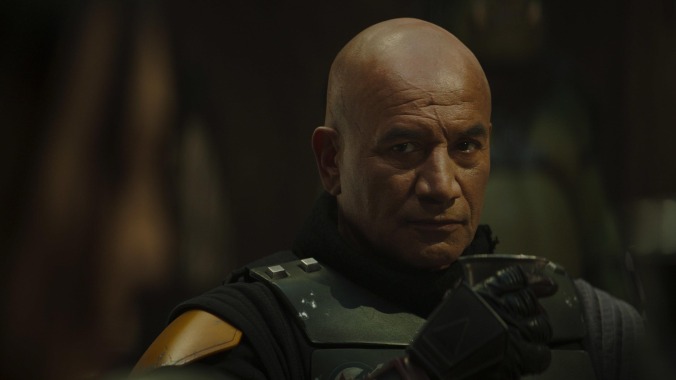Boba Fett's survival speaks to the different goals of old Star Wars and new Star Wars
The Book Of Boba Fett has revealed how the bounty hunter survived his apparent death, but how and why does it differ from the old version?

The Book Of Boba Fett has just premiered on Disney+, and with it we finally have an explanation for how Boba Fett survived his fall into the mouth of the sarlacc in Return Of The Jedi: He just… kind of punched his way out, then blew some holes in the monster with a wrist-mounted flamethrower. It clearly took a toll on Fett, who must now sleep in a bacta tank to heal, but the key point is that he’s out, he’s got his armor back (as seen in The Mandalorian), and he’s ready to take over Jabba The Hutt’s old criminal empire.
But things didn’t always happen that way. When Disney bought Lucasfilm and took over the Star Wars series, it declared that everything in the old “Expanded Universe” (as in, all Star Wars stories that aren’t part of the movies, like books and comics and games) were no longer canonical and therefore did not happen in the franchise’s continuity. One of the books jettisoned into the realm of what is now referred to as Star Wars Legends was Tales From Jabba’s Palace, an anthology which included a story called “A Barve Like That: The Tale Of Boba Fett.” In “A Barve Like That,” Boba Fett survives his fall into the mouth of the sarlacc—but that’s just about where the similarities between it and the Disney+ version stop.
How did Boba Fett escape the sarlacc in the Expanded Universe?
In “A Barve Like That,” Fett spends a long time stuck in the sarlacc as its digestive system breaks down his armor. While there, Fett learns that the sarlacc is sort of an intelligent beast that forms a psychic bond with the beings it digests, most notably a man named Susejo who was the first person eaten by the sarlacc and whose consciousness merged with the sarlacc’s to allow it to communicate.
Fett and the sarlacc, through Susejo, have conversations about their lives, and after figuring out a way to manipulate Susejo, Fett tricks the sarlacc into blowing up his jetpack and giving him a way out. Boba Fett returns later, promising the sarlacc and Susejo that he’ll kill them someday. It makes the pit itself a bigger part of the story and adds to the mystery and wonder implied by Return Of The Jedi’s claim that the sarlacc takes a thousand years to digest its prey.
How does Disney’s approach to Star Wars differ from the Expanded Universe’s?
Rather than just different approaches to the same subject matter, though, these two variations of the story illustrate the different approaches that Disney and the old EU brought to Star Wars. The old EU, in this story and others, was at least partially about taking things from the Star Wars movies and expanding on them, giving names and backstories to characters who only ever pass by in the background and shedding light on what they do before and after Luke Skywalker and his friends enter their lives.
Disney, in its streaming series in particular, is focusing more on recapturing what people liked about Star Wars in the first place. It’s not trying to expand on Star Wars and offer new insights on characters you may not have known or cared about before, it’s trying to make more Star Wars that faithfully emulates what’s good about the original movies. So far, that has resulted in stories that feel consistent with the best parts of Star Wars and don’t drastically alter what we think we know about this universe.
In the book (not The Book), the sarlacc’s relative sentience is a surprise that changes how we might feel about the big sand pit with teeth seen in the movies. In the show, it’s just a big sand pit with teeth that Boba Fett fights his way out of. Both approaches have their merits, since the old EU had more freedom to get weird and fantastical (but also had a tendency to get dark and edgy in a way that, in retrospect, doesn’t work for Star Wars) while the current crop of Disney-branded expansions are arguably better and more competently assembled.
One could argue that Disney’s reluctance to get weird and fantastical is hurting the franchise, since the company seems intent on making sure that Star Wars is safe and familiar more than anything (see: The Rise Of Skywalker’s unrepentant dismantling of the interesting questions about who Star Wars is for that were raised by The Last Jedi), but also nothing in the old EU got the love or attention on a big scale that The Mandalorian and The Book Of Boba Fett have.
Those stories were always supplemental, a thing you could take alongside the movies but were by no means expected to. The Disney+ shows, on the other hand, aren’t explicitly labeled as some separate thing, they’re just part of Star Wars as it is now. That opens the door for more a specialized story like The Book Of Boba Fett that doesn’t necessarily have to involve the Skywalkers, but with Disney currently so focused on maintaining Star Wars consistency in the wake of the divisive sequel trilogy, it might be a while before things get weird and fantastical again.